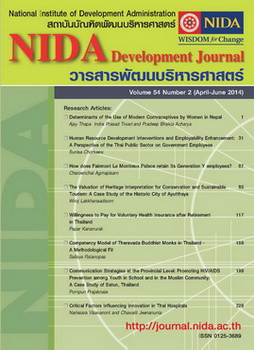Competency Model of Theravada Buddhist Monks in Thailand - A Methodological Fit
DOI:
https://doi.org/10.14456/ndj.2014.18Keywords:
Competency model, Theravada Buddhist monks, MethodologyAbstract
The competency model of Theravada Buddhist monks in Thailand was derived from a view of a pragmatist, using the grounded theory approach, and mixed methods as the research methodology. This research contains three sequential steps. First, a survey of 357 monks tallied by frequency analysis produced the name list of persons with best practices (BPs). Second, evidence-based competency interviews with 22 BPs, which were analyzed using thematic analysis, with the help of Atlas.ti, generated the lists of role-based behaviors. The third and last step was the process of the Delphi technique, with 28 subject matter experts (SMEs) that assessed the importance and the impact of those behaviors, analyzed using descriptive statistics. The filtered results were fine-tuned to create the concluding model.
The competency model of Theravada Buddhist monks in Thailand that emerged from this research is comprised of two clusters: one of generic competencies and the other of functional competencies. The eight generic competencies include: 1) mastering Dhamma knowledge; 2) observing monastic conduct; 3) sustaining Buddhist longevity; 4) rightful execution; 5) authentic-modern integration; 6) mindful elevation; 7) faith building; and 8) relationship building. The six functional competencies are: 1) Vinaya guarding; 2) Pali preserving; 3) purposeful orchestrating; 4) Dhamma disseminating; 5) appropriating artifacts; and 6) socially engaging. The competency model can be a starting point for individual monks to plan their development or for the monastic organizations to ignite changes.





